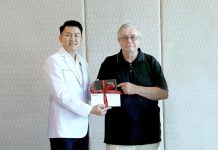The Aedes aegypti mosquito is alive and well, bringing with it the dangerous Dengue Fever virus. For some reason or other, the public has not taken the notion on board that Dengue can kill. Reading the journals I see that so far this year, 44 people have died in Thailand. That’s more than the bird flu numbers which were about 17 for this country. Can you see just how dangerous this virus really is?
Actually, Dengue has become endemic throughout the world. There are 2.5 billion people living in Dengue endemic areas, and Thailand is but one of them.
I was reminded of this topic the other day when I saw that on one day alone, Dengue Fever was the reason for hospitalization of five percent of the foreign in-patients. That is a lot! In fact, we are getting increasing inpatient numbers including the dangerous Dengue Hemorrhagic Fever (DHF).
Dengue Fever is another of those viral illnesses, and we have no direct answer to the virus. There is no “antibiotic” for the Dengue virus. Like Malaria, the virus is carried by mosquitoes, this time by one called Aedes aegypti.
With the monsoon rains we have been having recently, this is one of the reasons that this disease is on the upsurge in this country – but there is something we can all do about it.
However, first you should understand a little more about Dengue. The mosquito Aedes aegypti lays its eggs in standing water (and there is plenty left each evening after the afternoon showers), preferring the clean water found in water tanks and pots, in the saucers under pot plants and even under the pet’s food dish. Inside discarded car tyres are another favorite spot. These mosquitoes are not of the adventurous type and feed during the day and spend their time within 200 meters of their hatchery. Consequently, the eradication of any local breeding areas becomes very important towards maintaining your own health, as you can see. Keep your home free from lying water for a radius of 200 meters and you’re looking good!
Simple Dengue (if you can call it that) has an incubation period of around 4 to 7 days and then the full blown symptoms of high fever and headache begin. The headache is usually behind the eyes and is made worse by eye movement. From there the pains progress to the limbs with acute muscle pains, which gave it the old name “Break Bone Fever”.
With our ability to treat the viral ailments being very limited, the defense against the Dengue virus lies in Health and Hygiene initiatives, to stop you getting mosquitoes in the house during the day. For example, do you regularly change the water in containers the Aedes aegypti mosquito might call home? Do you have mosquito screens? Does baby sleep under a mosquito net? If the answer to these questions is “no”, then perhaps it is time to look critically at your own Dengue prevention plan. Let me assure you, it is not a disease you want! And the Hemorrhagic form in particular can be lethal.
The other precautions are to wear long trousers and long sleeved shirts, especially at sun up and sun down, when the mosquito is at its most ravenous.
The other factor to remember is “D” for Dengue and “D” for DEET. DEET is the magic ingredient in mosquito repellents, so when you go to buy some repellent, check the label – if it has DEET, then get it. And then remember to use it!
Some news to hand is that Purdue University in the United States claimed that papaya leaf consists of over 50 active ingredients found to kill fungi, worms, parasites, bacteria and many forms of cancer cells and sparkle up your immune system. For dengue fever it is suggested that the juice is extracted by crushing fresh leaves of papaya. One leaf of papaya gives about one tablespoon of juice. Two tablespoons of papaya leaf juice are given to dengue patients three times a day – once every six hours, with miraculous results. However, before you start crushing and juicing, the results came from five patients only! I wonder if Som Tam is just as good?




